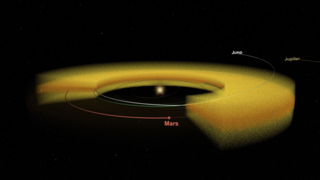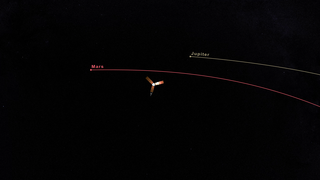Planets and Moons
ID: 4839
Look up to the night sky just before dawn, or after dusk, and you might see a faint column of light extending up from the horizon. That luminous glow is the zodiacal light, or sunlight reflected toward Earth by a cloud of tiny dust particles orbiting the Sun. Astronomers have long thought that the dust is brought into the inner solar system by a few of the asteroid and comet families that venture in from afar. But now, a team of Juno scientists argues that the planet Mars may be the culprit. An instrument aboard the Juno spacecraft serendipitously detected dust particles slamming into the spacecraft during its journey from Earth to Jupiter. The impacts provided important clues to the origin and orbital evolution of the dust, resolving some mysterious variations of the zodiacal light.
This page provides a data visualization of Juno’s trajectory from Earth to Jupiter, and the interplanetary dust cloud that it traversed along the way. Learn more about this discovery.
Juno Interplanetary Dust: Visualizations
This page provides a data visualization of Juno’s trajectory from Earth to Jupiter, and the interplanetary dust cloud that it traversed along the way. Learn more about this discovery.
Used Elsewhere In
Related
For More Information
Visualization Credits
Kel Elkins (USRA): Lead Visualizer
Dan Gallagher (USRA): Lead Producer
John Connerney (NASA/GSFC): Lead Scientist
Dan Gallagher (USRA): Lead Producer
John Connerney (NASA/GSFC): Lead Scientist
Please give credit for this item to:
NASA's Scientific Visualization Studio
NASA's Scientific Visualization Studio
Short URL to share this page:
https://svs.gsfc.nasa.gov/4839
Mission:
Juno
Data Used:
Note: While we identify the data sets used in these visualizations, we do not store any further details nor the data sets themselves on our site.
Keywords:
SVS >> Dust
SVS >> Dust Cloud
SVS >> Jupiter
SVS >> Mars
SVS >> Hyperwall
SVS >> Juno
NASA Science >> Planets and Moons
SVS >> Animation
SVS >> Trajectory
SVS >> Zodiacal Light
SVS >> Interplanetary
https://svs.gsfc.nasa.gov/4839
Mission:
Juno
Data Used:
Keywords:
SVS >> Dust
SVS >> Dust Cloud
SVS >> Jupiter
SVS >> Mars
SVS >> Hyperwall
SVS >> Juno
NASA Science >> Planets and Moons
SVS >> Animation
SVS >> Trajectory
SVS >> Zodiacal Light
SVS >> Interplanetary













